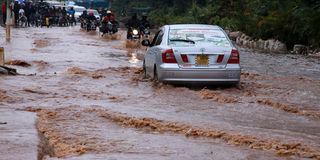Tips for driving safely during rainy conditions

To reduce chances of hydroplaning, slow down, avoid hard braking or turning sharply and drive in the tracks of the vehicle ahead of you. Photo/Rachel Mabala
What you need to know:
Wet weather driving can be hazardous, causing skids, hydroplaning, and slick roads. Now that the rains are here with us, these tips will help you stay safer on the road.
We all hear about the importance of safe and defensive driving during wet road conditions. All drivers are aware of the fact that it takes longer to bring a car to a full stop in rainy conditions than when the road is dry, as water significantly decreases the friction between the tyres and the road and the overall traction of the car.
However, I believe that people only fully appreciate how difficult it is to brake on the wet road and how much time and distance they need to stop their car abruptly only after they have to deal with this situation at least once.
Slow down
This should be obvious but it is also very important. People are so used to driving at certain speeds on certain roads that sometimes they forget the need to slow down when bad weather presents itself.
The deprived windshield wipers are easily forgotten and taken for granted until you really need them. You will actually understand its importance when you drive a car with worn out ones or even none.
If they are worn out and cannot keep up with the rain, it is really your own fault because you did not think about it beforehand.
Since about 90 per cent of all driving decisions are based on what you can see, it makes sense to have great working wipers so you can see. Be proactive and change your wipers at least annually.
See and be seen
We are currently experiencing enormous downpours and as drivers, it is imperative we take caution. Things such as knowledge of the fact that in rainy conditions, it is more strenuous to see other cars, road signs and the road itself. It is critical to make sure you can see and be seen.
Drive in the tracks of a car ahead of you while watching out for brake lights. Do not follow large trucks or buses too closely. The spray created by their large tyres reduces your vision. Take care when passing them as well; if you must pass, do so quickly and safely.
Avoid hard braking; if possible, take your foot off the accelerator to slow down.
Turn your headlights on even in a light rain, or in gloomy or foggy conditions. They will definitely help other drivers see you. Newer cars have daytime running lights, which do the job just as well.
Visibility
Never drive beyond the limits of visibility. At night, rainy roads become especially treacherous. The glare of oncoming lights, amplified by the rain on your windscreen, can cause temporary loss of visibility while substantially increasing driver fatigue. In rainy conditions pedestrians and livestock are extremely hard to spot and even harder to avoid.
When driving through a puddle of uncertain depth, go slow. If it is deeper than the bottom of your doors, turn around and find another route. Deep water can cause serious damage to a modern car’s electrical system.
Finally, it is only courteous and respectful to avoid splashing water on pedestrians.
Avoid cruise control
According to defensivedriving.org, using cruise control during wet weather can cause you to lose control of your vehicle. Drivers may need to reduce speed by easing off the accelerator to prevent traction loss, but this is not possible when using cruise control.
Additionally, the driver must remain fully engaged during wet weather driving, so cruise control should be avoided.
Drive smarter
Smart people adjust their strategy around changing conditions. Weather is one of those things. When driving in rain or any inclement weather be careful and pull back:
Keep your distance. You never know when the person ahead of you will spin out.
Do not tailgate, especially in limited visibility.
Slow down. Take corners slower.
Be patient. Expect extra traffic.




